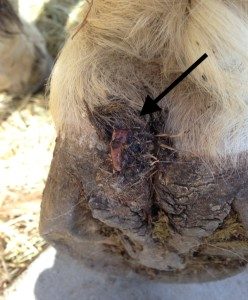 By Maddy Butcher
By Maddy Butcher
If there could be one shining example to illustrate the saying, “there’s always more to learn about horses,” it’d be hoof abscesses.
Think of an abscess as a boil or bubble of infection inside the hoof. As it grows and “searches” for an exit surface (sometimes at the hair line, sometimes at the heel bulb, sometimes through the sole), it can turn a sound horse dramatically lame.
Abscesses are typically simple and affordable to remedy, but, boy-oh-boy, can they be scary. I consider myself a savvy, hoof-abscess veteran, yet they continue to fool me.
Here are some related experiences and helpful recommendations.
To the inexperienced eye, abscesses can look like shoulder injuries, hock injuries, hip or back injuries. Horses can limp lightly or be dead lame. As you call the vet, you can be panicking with worst-case scenarios. They can crop up gradually or all of a sudden.
9 times out of 10, it’s an abscess, in my experience.
Individual horses seem to be more prone or more resistant to abscesses. Hard hooves developed on dry, rugged terrain might be more resistant, but if abscesses do develop, they’ll have a harder time getting through a surface for rupture and relief.
Abscesses can crop up with the change of season. “With changes in temperature, the hoof can expand and contract. The moist ground can soften the foot to expose it to bacterial migration with those changes,” said Dr. Kate Schoenhals, of South Mountain Equine.
Abscesses are often treated successfully by soaking with warm water and Epsom salt. Some recommend adding betadine until the water is the color of tea. Soaking encourages the abscess to work towards a surface and rupture. With rupture comes relief and healing (assuming there’s no resulting infection).
Here are some general soaking suggestions:
- Train your horse to place a hoof in a pan or bucket before you deal with an abscess. Make it a positive, rewarding, non-stressful experience.
- Still a struggle? Experiment with adding the water before or after the hoof is in the pan.
- Some horses can be especially balky with hind feet. If that’s the case, try placing the front feet in an empty pan and then moving to the hind end.
- Also, if a horse is especially snarky with a back hoof, use a rope looped around the fetlock to safely lift and lower the leg.
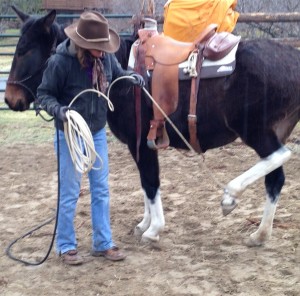 Soak two or three times a day, at least 15 minutes a time. I like to have the water as hot as my horse will tolerate.
Soak two or three times a day, at least 15 minutes a time. I like to have the water as hot as my horse will tolerate.- Use a rubber bucket. It’s quieter and more comfortable than plastic or metal for your horse.
- Make sure the water level is above the coronet band (where the hair meets the hoof).
- You might never see an erupted abscess, but you will likely smell it. It stinks!
Some soak hooves by placing them in a discarded IV bag or thick Ziploc bag filled with water and Epsoms, then duct-taping the package just north of the fetlock.
Also:
Some folks “dig” for an abscess, cutting the sole where they’ve determined the abscess to be. This is generally not recommended. There will be more hoof that must heal and it could introduce infection.
Some folks use hoof pads and/or baby diapers with poultice (also called magna paste), wrapped with vet wrap and/or duct tape to draw out the infection when soaking isn’t an option.
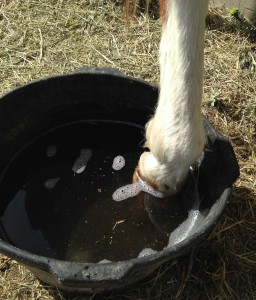
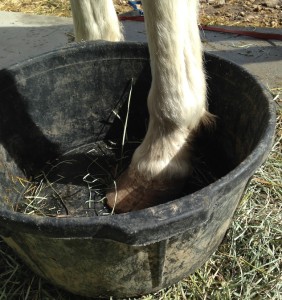
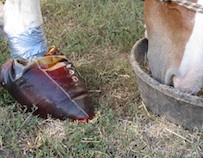
Very timely! I just had a horse come in dead lame in a back hoof. Called the vet-now I’m soaking twice a day.
This is a handy 2min video on how to make a duct tape hoof patch. 🙂
Hi Anne… Id love to see the video…can u repost?
Becky
Anne, i’d like to see the video, too.
where’s the video?
The wife and had great success using a rubber pail with warm water and Epsom Salt. We tested the water on the in side of the for arm, the same as you would as a babies bottle, to be Sure it’s not hot. We also recommend that you practice this, so the animal is comfortable doing it before you have to do this with a sore hoof, and things go South in a real hurry. A bad experience for all parties involved. We made shore the water level was well above the coronet band, it just seamed that we had we had a greater area to hold the heat, and we would have better results sooner. We never had an issue with putting the rear hoof in a pail, the use of the [roped looped around the fetlock] sounds like a good idea.
” Digging for an abscess” sounds like a disaster in the making,. keep in mind you are dealing with a hoof that is sore, and about the time you hit a tender spot, you can expect to punched by a flying hoof that probably wont end well for you.
I can see were an IV bag would work well, I would keep the Duck Tape wrapping to hold the IV bag in place on the IV bag. If you wrap the Duck Tape to the hair, upon removable it would be like Duck Tape being removed from your hair, an event that probably that won’t end well.
Use a hoof soaking boot! It is much easier and less stressful for you and your horse, it does a very good job of soaking the hoof.
I wish this information would be shared with people. Much easier and safer than trying to keep a horses hoof in a tub or bucket 3 times a day for 20 minutes.